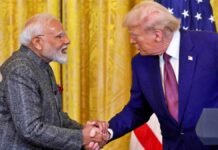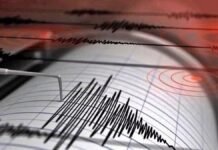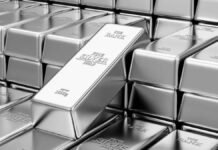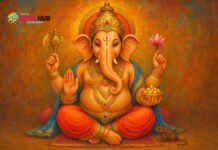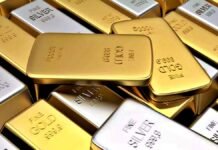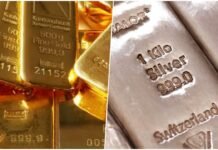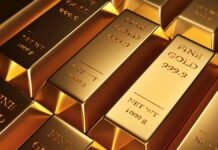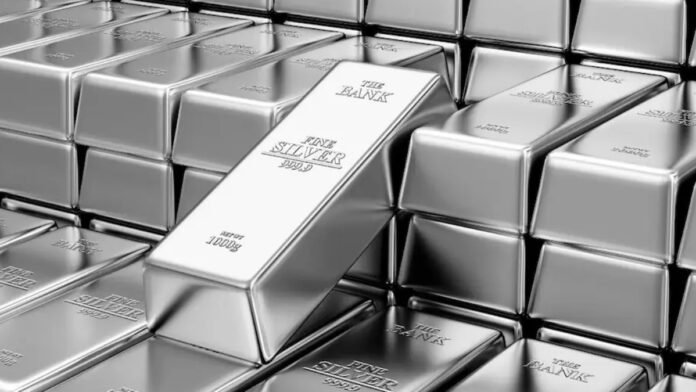
Key Points
- Silver surges to historic high of ₹1,65,500 per kg, reaching ₹1,68,500 with 3% GST
- Unprecedented ₹11,000 single-day jump on Thursday marks largest ever increase
- Silver gains ₹13,300 in just two days ahead of Karva Chauth and Diwali festivities
- Wednesday saw ₹2,300 rise, continuing upward momentum
- Silver now delivering higher returns than gold for investors
- Gold reaches ₹1,23,300 per 10 grams (₹1,26,300 with GST) after ₹700 increase
- International industrial demand driving 60-70% of silver consumption
- Traders predict silver could cross ₹1.80 lakh before Diwali, potentially hitting ₹2 lakh mark
- Festive season buying adds to price pressure ahead of major celebrations
New Delhi: Silver has stunned precious metals markets with an unprecedented price surge just days before the auspicious occasions of Karva Chauth and Diwali, shattering all previous records and leaving investors and buyers scrambling to adjust their purchasing strategies. The white metal’s extraordinary rally has overshadowed gold’s traditional dominance during the festive season, delivering exceptional returns that have caught both traders and consumers by surprise.
Record-Breaking Single-Day Surge
On Thursday, silver prices experienced their most dramatic single-day increase in history, skyrocketing by an astounding ₹11,000 per kilogram to reach an all-time high of ₹1,65,500. When the mandatory 3% Goods and Services Tax is factored in, the effective price for consumers stands at ₹1,68,500 per kilogram, representing a significant financial barrier for those planning festive purchases.
This remarkable ₹11,000 jump in a single trading session represents the largest one-day increase ever recorded in India’s silver market. The magnitude of this surge has sent shockwaves through the precious metals trading community, with analysts scrambling to reassess their price forecasts and market projections for the coming weeks.
The unprecedented volatility demonstrates the growing influence of global market dynamics on domestic precious metals prices, highlighting silver’s increasingly speculative nature and its sensitivity to international industrial demand patterns.
Consecutive Days of Explosive Growth
Thursday’s record-breaking surge followed an already impressive performance on Wednesday, when silver prices climbed by ₹2,300 per kilogram. This means that over just two consecutive trading days, silver has gained an extraordinary ₹13,300 per kilogram, representing an approximate 8-9% increase in value within 48 hours.
This consecutive-day rally marks one of the most aggressive upward price movements witnessed in India’s silver market in recent years. The sustained momentum suggests strong underlying demand pressures and favorable market conditions that extend beyond typical festive season buying patterns.
For investors who purchased silver even a week ago, these price movements have translated into substantial paper gains, vindicating those who bet on silver’s potential to outperform other investment options during this period.
Silver Outshines Gold Returns
Traditionally, Indian consumers and investors have gravitated toward gold during festive seasons, viewing it as the premier precious metal for both investment and ornamental purposes. However, silver’s recent performance has dramatically altered this conventional wisdom, with the white metal now delivering significantly higher returns than gold.
While gold has also experienced price appreciation, rising by ₹700 to reach ₹1,23,300 per 10 grams (₹1,26,300 including GST), its percentage gains pale in comparison to silver’s explosive growth. This divergence in performance has prompted many investors to reconsider their portfolio allocations and explore silver as a more dynamic investment opportunity.
The shift in relative performance between gold and silver has important implications for festive season purchasing decisions. Many families who traditionally invest in gold jewelry or coins during Diwali are now evaluating whether silver presents better value or investment potential, despite its own elevated price levels.
Festive Season Impact and Consumer Anxiety
The timing of this unprecedented price surge has created considerable anxiety among consumers planning festive purchases ahead of Karva Chauth and Diwali. These occasions hold immense cultural and religious significance in Indian society, with the purchase of precious metals considered auspicious and traditional.
Karva Chauth, an important Hindu festival celebrated by married women, typically sees increased demand for silver items including jewelry, utensils, and decorative pieces. Similarly, Diwali—India’s most important festival—traditionally drives massive precious metals purchases as families buy gold and silver for investment, gifting, and worship purposes.
The sharp price escalation has forced many consumers to either reduce the quantity of silver they planned to purchase, postpone their buying decisions in hopes of a price correction, or shift to alternative options. Jewelry retailers report that customers are expressing shock and concern at the dramatically higher prices compared to even a week ago.
International Demand Driving Domestic Prices
Market experts and trading professionals attribute the current silver price explosion primarily to international rather than domestic factors. This represents a crucial distinction, as it suggests that Indian market conditions alone cannot explain the extraordinary price movements witnessed in recent days.
The industrial sector accounts for an estimated 60 to 70 percent of total global silver demand, significantly higher than gold’s industrial usage. Silver’s unique properties—including superior electrical conductivity, thermal conductivity, and antimicrobial characteristics—make it indispensable in numerous industrial applications including electronics manufacturing, solar panel production, medical equipment, and emerging green technologies.
Global industrial demand for silver has intensified due to several converging factors. The ongoing transition toward renewable energy sources has dramatically increased silver consumption in solar panel manufacturing, where the metal serves as a critical component in photovoltaic cells. Electric vehicle production, which requires substantially more silver per unit than conventional automobiles, continues expanding rapidly as countries push toward electrification of transportation.
Additionally, the electronics industry’s sustained growth, particularly in semiconductor manufacturing and consumer devices, maintains steady silver demand. The metal’s superior conductivity properties make it irreplaceable in many high-performance applications where alternatives cannot match its technical specifications.
Traders’ Bullish Outlook and Price Predictions
Precious metals traders have adopted an increasingly bullish stance on silver’s near-term price trajectory, with some predicting that the metal could breach the ₹1.80 lakh per kilogram threshold before Diwali celebrations conclude. If international demand patterns persist and no major market disruptions occur, some analysts believe silver could eventually challenge the ₹2 lakh per kilogram mark in the coming months.
These optimistic projections reflect confidence in sustained industrial demand, potential supply constraints, and continued investor interest in precious metals as inflation hedges and portfolio diversification tools. However, such aggressive price targets also carry inherent risks, as sharp rallies often attract speculative activity that can lead to equally dramatic corrections.
Traders emphasize that silver markets exhibit greater volatility than gold due to the metal’s smaller market size and its dual nature as both an industrial commodity and investment asset. This volatility can create opportunities for substantial gains but also exposes investors to considerable downside risks if market sentiment shifts suddenly.
Gold Price Movements and Comparative Analysis
While overshadowed by silver’s spectacular performance, gold has maintained its own upward trajectory, rising by ₹700 on Thursday to reach ₹1,23,300 per 10 grams. With the addition of 3% GST, consumers face an effective gold price of ₹1,26,300 per 10 grams, which remains near historical highs though below previous peak levels.
Gold’s relatively modest gain compared to silver reflects the different demand dynamics influencing each metal. Gold prices respond primarily to factors including central bank monetary policies, currency fluctuations, geopolitical tensions, and investment demand for safe-haven assets. While these factors remain supportive of gold prices, they have not generated the explosive momentum currently characterizing silver markets.
The gold-silver ratio, which measures how many ounces of silver are required to purchase one ounce of gold, has compressed significantly during silver’s recent rally. This ratio serves as an important indicator for traders deciding between the two metals, and its current level suggests silver has gained substantial relative value compared to historical norms.
Investment Implications and Consumer Strategies
The current precious metals price environment presents both opportunities and challenges for various market participants. Long-term investors who accumulated silver positions before the recent surge have realized substantial gains and now face decisions about profit-taking versus maintaining exposure to potentially further appreciation.
For new investors considering silver purchases at current elevated levels, the decision becomes more complex. While momentum remains strong and industrial demand fundamentals appear solid, the magnitude of recent price increases raises legitimate concerns about potential near-term corrections. Technical analysis suggests that such rapid price movements often lead to consolidation periods or pullbacks as markets digest gains.
Consumers planning festive season purchases face difficult choices. Waiting for potential price corrections risks missing purchase opportunities if prices continue rising, while buying at current levels means accepting historically high prices with uncertain future direction. Some consumers are adopting a middle-ground strategy of making partial purchases now while reserving funds for potential future buying opportunities if prices moderate.
The extraordinary silver price surge ahead of Karva Chauth and Diwali has fundamentally altered the precious metals landscape, challenging traditional assumptions about gold’s superiority and highlighting silver’s growing importance as both an industrial commodity and investment asset. Whether these elevated prices represent sustainable new levels or an overextended rally that will eventually correct remains the critical question facing market participants in the days and weeks ahead.


